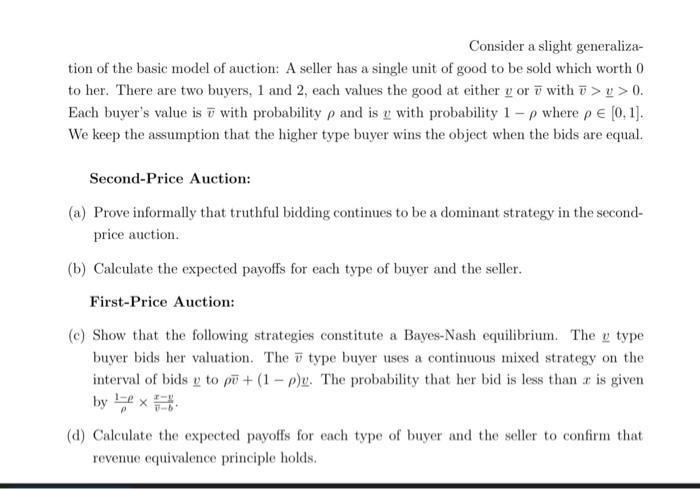Answered step by step
Verified Expert Solution
Question
1 Approved Answer
Consider a slight generaliza- tion of the basic model of auction: A seller has a single unit of good to be sold which worth

Consider a slight generaliza- tion of the basic model of auction: A seller has a single unit of good to be sold which worth 0 to her. There are two buyers, 1 and 2, each values the good at either y or with >y> 0. Each buyer's value is with probability p and is u with probability 1-p where p = [0, 1]. We keep the assumption that the higher type buyer wins the object when the bids are equal. Second-Price Auction: (a) Prove informally that truthful bidding continues to be a dominant strategy in the second- price auction. (b) Calculate the expected payoffs for each type of buyer and the seller. First-Price Auction: (c) Show that the following strategies constitute a Bayes-Nash equilibrium. They type buyer bids her valuation. The type buyer uses a continuous mixed strategy on the interval of bids y to pu+ (1-p)u. The probability that her bid is less than a is given by x (d) Calculate the expected payoffs for each type of buyer and the seller to confirm that revenue equivalence principle holds. Consider a slight generaliza- tion of the basic model of auction: A seller has a single unit of good to be sold which worth 0 to her. There are two buyers, 1 and 2, each values the good at either y or with >y> 0. Each buyer's value is with probability p and is u with probability 1-p where p = [0, 1]. We keep the assumption that the higher type buyer wins the object when the bids are equal. Second-Price Auction: (a) Prove informally that truthful bidding continues to be a dominant strategy in the second- price auction. (b) Calculate the expected payoffs for each type of buyer and the seller. First-Price Auction: (c) Show that the following strategies constitute a Bayes-Nash equilibrium. They type buyer bids her valuation. The type buyer uses a continuous mixed strategy on the interval of bids y to pu+ (1-p)u. The probability that her bid is less than a is given by x (d) Calculate the expected payoffs for each type of buyer and the seller to confirm that revenue equivalence principle holds. Consider a slight generaliza- tion of the basic model of auction: A seller has a single unit of good to be sold which worth 0 to her. There are two buyers, 1 and 2, each values the good at either y or with >y> 0. Each buyer's value is with probability p and is u with probability 1-p where p = [0, 1]. We keep the assumption that the higher type buyer wins the object when the bids are equal. Second-Price Auction: (a) Prove informally that truthful bidding continues to be a dominant strategy in the second- price auction. (b) Calculate the expected payoffs for each type of buyer and the seller. First-Price Auction: (c) Show that the following strategies constitute a Bayes-Nash equilibrium. They type buyer bids her valuation. The type buyer uses a continuous mixed strategy on the interval of bids y to pu+ (1-p)u. The probability that her bid is less than a is given by x (d) Calculate the expected payoffs for each type of buyer and the seller to confirm that revenue equivalence principle holds. Consider a slight generaliza- tion of the basic model of auction: A seller has a single unit of good to be sold which worth 0 to her. There are two buyers, 1 and 2, each values the good at either y or with >y> 0. Each buyer's value is with probability p and is u with probability 1-p where p = [0, 1]. We keep the assumption that the higher type buyer wins the object when the bids are equal. Second-Price Auction: (a) Prove informally that truthful bidding continues to be a dominant strategy in the second- price auction. (b) Calculate the expected payoffs for each type of buyer and the seller. First-Price Auction: (c) Show that the following strategies constitute a Bayes-Nash equilibrium. They type buyer bids her valuation. The type buyer uses a continuous mixed strategy on the interval of bids y to pu+ (1-p)u. The probability that her bid is less than a is given by x (d) Calculate the expected payoffs for each type of buyer and the seller to confirm that revenue equivalence principle holds.
Step by Step Solution
★★★★★
3.40 Rating (159 Votes )
There are 3 Steps involved in it
Step: 1
SecondPrice Auction a In a secondprice auction the highest bidder wins the object but pays the secondhighest bid Truthful bidding remains a dominant s...
Get Instant Access to Expert-Tailored Solutions
See step-by-step solutions with expert insights and AI powered tools for academic success
Step: 2

Step: 3

Ace Your Homework with AI
Get the answers you need in no time with our AI-driven, step-by-step assistance
Get Started


